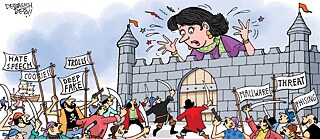Digital Resilience
Words to Build Your Safety Net

The internet gives you access to everything, but can also give everything access to you. Read on to learn how to be a safe and discerning digital explorer.
By Rebecca Johns
Our lives are intricately woven into the fabric of the internet. We shop online, connect with friends and family, and even manage our finances through online platforms. This has revolutionised the way we live, work, and play, but also challenges our safety and privacy.
There are countless online threats to our data - and equally numerous ways to identify and manage risks. Your experience helps you build digital resilience as you learn who to trust and how to best judge the safety of your actions - even while you work, socialise and explore the online world.
Here are some terms that will help you, a digital reader, develop a safety net as you browse:
Cybersecurity
Most of our devices come with pre-installed security software that runs routine scans. Investing in reliable cybersecurity software has become essential for safeguarding your digital information. It protects your internet-connected systems from unauthorised access. This is a vital step to prevent cyberattacks aimed at stealing, changing, or destroying your private information.
Malware
This is a term used for the malicious softwares designed to disrupt, damage, or gain access to your device or information. Malware is intentionally built to fly under the radar. However, your cybersecurity system is designed to flag and protect your devices from malware.
Encryption
Many platforms boast encryption as a method of added security, from search engines like Google, to social media sites like LinkedIn, to streaming sites like Netflix. It is a way to scramble your information into code, so that only those authorised with the key can read it. Encryption ensures that your sensitive data remains secure, like your passwords, financial details, and private information.
Phishing
A fraudulent attempt to obtain sensitive information, such as usernames, passwords, or credit card details, disguised as a trustworthy entity in a digital message, is known as phishing. Phishing scams have long been a problem, and continue to evolve over time. Be wary of visiting unknown links or clicking on pop ups, especially those presented with urgency.
Two-Factor Authentication (2FA)
2FA is an extra layer of security that requires you to provide two different authentication factors when you log in to a site. To gain access to your digital accounts or profiles, safe sites typically need two identifiers: usually a password, and code that may be sent via text message. Enabling 2FA enhances your account security, making sure only you can get in.
Cookies
Ever accessed a website and seen a pop up that says, “this site uses cookies”? We often skim over and accept them, but it is important to be discerning. Cookies are small text files that work to increase a website’s functionality, and gather information for targeted advertising. Do not accept cookies on websites that request sensitive information, even if prompted. Your device should have a “clear all cookies” option which you should use to periodically delete the information stored by websites and advertisers.
Privacy Policy
Every website should have a page that explains how a website or online service collects, uses, and protects your information. Reading privacy policies helps you make informed decisions about sharing your data online. If you don’t have time to sift through all the information, be wary. Only visit reputed sites, and avoid storing your sensitive information on them.
Data Breach
Despite all safety measures, it is possible for your confidential or protected data to be wrongly accessed. If you are aware of what has been stolen or disclosed, you will be able to formulate a plan to control a data breach. Some ways to stay secure are by routinely changing passwords and monitoring your accounts.
Digital Footprint
The trail of data you create while using the internet, including your online activities, interactions, and the information you share is known as a digital footprint. Being mindful of your digital footprint helps protect your online privacy. Be wary of falling for websites that use exaggerated language to maximise clicks, thereby increasing your footprint and the chances of a data breach.
Navigating the digital landscape safely requires a basic understanding of internet safety and privacy jargon. By familiarising yourself with these terms, you can take more informed actions to protect your online presence, personal information, and digital security.
Remember, staying safe online is an ongoing process. Continue to educate yourself as the technology around you evolves. This will help you to be a more responsible and resilient digital reader.